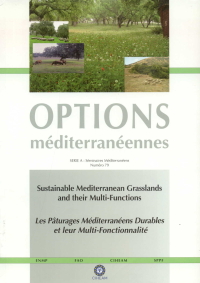| Article précédent | p. 211-214 | Article suivant |
Herbage production and nutritive value of Dactylis glomerata L. and Trifolium subterraneum L. alone and in mixture
Herbaceous species, in rainfed pastures of the Mediterranean zone, reach maturity very early in the growing season due to the warm and drought conditions. Introduction of drought tolerant grass and legume species in the appropriate mixture could increase the herbage production and the nutritive value. The objective of this paper was to compare monocultures and replacement series mixtures of Dactylis glomerata L. cv. Palestina and Trifolium subterraneum L. cv. M. baker and to define which mixture was the most pertinent to achieve higher production and nutritive value. The experiment was conducted on the farm of the Aristotle University of Thessaloniki, Northern Greece. The five planting proportions were monocultures of each species and mixtures at 75:25%, 50:50% and 25:75% (D. glomerata, T. subterraneum). The experimental design was a completely randomized block with three replications. D. glomerata had a higher yield per individual when grown in mixtures with T. subterraneum than in monocultures, whereas the yield per individual of T. subterraneum was lower in mixtures with D. glomerata than in monocultures. T. subterraneum was a consistently weak competitor in relation to D. glomerata. Total herbage production of D. glomerata was not affected by the mixture, whereas total herbage production of T. subterraneum as well as total herbage production independently of plant species was significantly higher in the 25:75% and in the 50:50% mixtures compared to the 75:25%. The nutritive value was slightly higher in the 75:25% and in the 50:50% mixtures compared to the 25:75%.
Le but de l'étude était l'analyse du comportement social des deux espèces fourragères Trifolium subteraneum et Dactylis glomerata en monoculture et en mélange, au niveau de la production fourragère et de la valeur nutritionnelle, afin de déterminer l'association d'espèces optimale. Le travail a été réalisé dans la station expérimentale de l'Université Aristote de Thessalonique (Grèce). Le dispositif expérimental était constitué de deux parcelles de monoculture (Dactylis glomerata L. et Trifolium subterraneum L.) et de trois parcelles de mélange (les deux espèces T. subterraneum et D. glomerata en mélange : 75:25%, 50:50%, 25:75%). Le dispositif statistique mettait en place des blocs aléatoires avec trois répétitions sur les parcelles des traitements. Les résultats obtenus montrent que le rendement en MS par plante chez le Dactyle était plus élevé en mélange qu'en monoculture ; tandis que le contraire survenait chez le T. subterraneum, qui semblait être un faible concurrent. Le rendement total en MS chez le Dactyle n'était pas affecté par les associations d'espèces ; à l'inverse, chez T. subterraneum il était plus élevé au niveau de 25:75% et 50:50%. La valeur nutritionnelle n'était guère élevée au niveau de 75:25%, 50:50%.
- [ Afficher ]
- [ Télécharger ]
- [ Exporter la citation ]
Vous pouvez télécharger la citation au format :
- [ Imprimer ]
-
Mots-clés
CULTURE EN MELANGE, CULTURE PURE, DACTYLIS GLOMERATA, EXPERIMENTATION, GRECE, PLANTE FOURRAGERE, RENDEMENT, TRIFOLIUM SUBTERRANEUM, VALEUR NUTRITIVECiter cet article
Kyriazopoulos A.P., Abraham E.M., Parissi Z.M., Nastis A.S. Herbage production and nutritive value of Dactylis glomerata L. and Trifolium subterraneum L. alone and in mixture. In : Porqueddu C. (ed.), Tavares de Sousa M.M. (ed.). Sustainable Mediterranean grasslands and their multi-functions . Zaragoza : CIHEAM / FAO / ENMP / SPPF, 2008. p. 211-214. (Options Méditerranéennes : Série A. Séminaires Méditerranéens; n. 79). 12. Meeting of the Sub-Network on Mediterranean Forage Resources of the FAO-CIHEAM Inter-regional Cooperative Research and Development Network on Pastures and Fodder Crop, 2008/04/09-12, Elvas (Portugal). http://om.ciheam.org/om/pdf/a79/00800648.pdf



